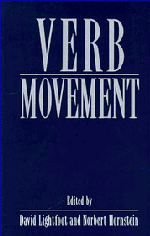Book contents
- Frontmatter
- Contents
- List of contributors
- Preface
- Verb movement: an introduction
- 1 Verb positions: evidence from Italian
- 2 Verb movement and word order in Arabic
- 3 Comments on the paper by Ouhalla
- 4 Some similarities and differences between Icelandic and Yiddish
- 5 Comments on the paper by Santorini
- 6 Finite verb movement in Scandinavian embedded clauses
- 7 Comments on the paper by Vikner
- 8 The Brythonic copula and head raising
- 9 A reinterpretation of evidence for verb movement in French
- 10 Two types of head movement in Romance
- 11 Comments on the paper by Roberts
- 12 Licensing heads
- 13 Comments on the paper by Koopman
- 14 Finiteness and head movement in early child grammars
- 15 Comments on the paper by Wexler
- References
- Index
Verb movement: an introduction
Published online by Cambridge University Press: 03 May 2011
- Frontmatter
- Contents
- List of contributors
- Preface
- Verb movement: an introduction
- 1 Verb positions: evidence from Italian
- 2 Verb movement and word order in Arabic
- 3 Comments on the paper by Ouhalla
- 4 Some similarities and differences between Icelandic and Yiddish
- 5 Comments on the paper by Santorini
- 6 Finite verb movement in Scandinavian embedded clauses
- 7 Comments on the paper by Vikner
- 8 The Brythonic copula and head raising
- 9 A reinterpretation of evidence for verb movement in French
- 10 Two types of head movement in Romance
- 11 Comments on the paper by Roberts
- 12 Licensing heads
- 13 Comments on the paper by Koopman
- 14 Finiteness and head movement in early child grammars
- 15 Comments on the paper by Wexler
- References
- Index
Summary
Generative grammarians have always been interested in the properties of movement operations. Emonds' notions on structure-preservation and the development of the “trace theory of movement rules” in the mid-1970s led to explanatory accounts of how noun phrases move syntactically. Theories emerged which predicted the positions to which NPs (both +wh and -wh) could move, the positions from which they could move, the positions from which they had to move, and the locality restrictions on the movement. More recently, we have gained some understanding of covert movement operations affecting wh phrases and quantificational NPs at the level of logical form (LF). In general, we have learned a great deal about the movement of phrasal categories. Indeed, much progress has been made despite there being little discussion about the nature of the movement itself: that is, after the development in the early 1970s of the successive cyclic movement of wh items, ideas remained fairly constant on what was being moved, the positions to which movement was taking place and the bounding condition on movement (Subjacency). This was so even during the radical reformulation provoked by the emergence of principles of government and binding. Understanding came through conditions imposed on the residues of movement, through notions like Case theory, which helped to distinguish positions from which NPs had to move, and through the constituent structure of clauses, which defined positions to which +wh and −wh NPs moved.
- Type
- Chapter
- Information
- Verb Movement , pp. 1 - 18Publisher: Cambridge University PressPrint publication year: 1994
- 3
- Cited by



